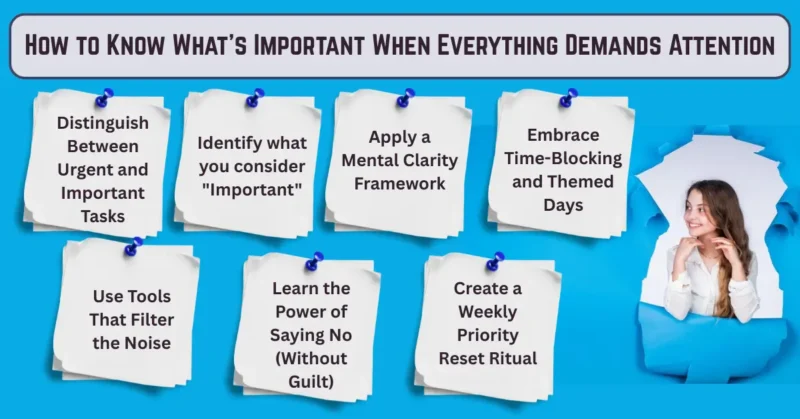Feeling overwhelmed by too many tasks? Learn how to prioritize what matters using expert strategies, simple frameworks, and practical tools. Get your focus back today.
Thank you for reading this post, don't forget to subscribe!How to Prioritize When Everything Feels Urgent: Expert-Backed Tips for Clarity
It’s easy to feel like you’re putting out flames all the time in today’s always-on society. Everything screams urgent, your to-do list never ends, and you’re stuck wondering, How do I know what’s essential? If you’ve ever felt overwhelmed by competing priorities or mentally paralyzed by too many tasks, you’re not alone.
This guide will help you cut through the chaos, identify what matters, and reclaim your mental clarity. Whether you’re a student, entrepreneur, working parent, or professional, these strategies will help you stop reacting to everything and start responding to what truly matters.
We’ve all had those days when every task, message, and notification feels like it needs our immediate attention. You start with good intentions — maybe even a to-do list — but soon, you’re pulled in a dozen directions, unsure where to focus. It’s not that you lack priorities — it’s that everything feels like a priority.
So, how do you figure out what truly matters when your time, energy, and mind are under constant pressure?
This guide offers a practical approach to finding clarity, even amid chaos. Let’s begin by understanding what’s happening.
The Modern Crisis of Prioritization
The human brain isn’t designed to manage 20 tabs open at once, mentally or digitally. Yet most of us live in a state of partial attention — juggling Slack messages, emails, texts, and to-do lists while feeling guilty about what we’re not doing.
This mental overload creates a sense of urgency where everything feels important, whether it is or not. It’s not just about poor time management. It’s a deeper issue of clarity and cognitive overload.
The first step in escaping this loop is to understand why you feel pulled in too many directions and realize that you don’t have to give everything equal weight.

Reclaiming Focus Through Intentional Attention
Before you even begin prioritizing tasks or using productivity frameworks, there’s one powerful concept that often gets overlooked: attention management. Unlike time, attention is flexible but limited, and mastering it helps you stay aligned with what truly matters, even when everything feels urgent.
Attention management means deliberately choosing what you engage with, both externally and internally. It’s the practice of creating the right environment for focus and developing habits that reinforce mental clarity throughout the day.
External Distractions: Take Back Control of Your Space
Let’s start with the outside world. In our digital age, notifications, emails, and interruptions are specifically designed to hijack your focus. You don’t need to eliminate technology; you need to reclaim control over it.
- Silence the noise. Turn off push notifications, email alerts, and messaging pop-ups. Choose specific times to check your inbox instead of living in it.
- Physically protect your focus. If you work in a busy space, consider wearing headphones, using a focus sign, or finding a quiet area for deep work. You can even coordinate “quiet hours” with teammates to create distraction-free blocks of time.
By curating your environment, you create space for focused attention — the kind that allows you to complete what’s essential.
Internal Distractions: Strengthen Your Mental Discipline
The trickier part? Your mind can become a distraction. Our brains are wired to seek novelty, which makes it hard to resist multitasking or constantly switching tasks. Even worse, many of us are conditioned to act on every thought, which can lead to a scattered day filled with low-impact tasks.
Here’s how to bring that focus back:
- Single-task intentionally. Instead of juggling multiple tabs or switching between tasks, keep just one window open and commit to it until you’re done or reach a stopping point.
- Create tech-free pockets. Step away from your devices for 20 to 60 minutes a few times a day. Use this time to recharge mentally, take a walk, or reset your thinking.
- Catch and redirect runaway thoughts. When your mind wanders or you recall something unrelated (such as replying to an email), please take note of the text below. It prevents task-hopping while honoring your thoughts.
With consistent practice, you’ll develop a focused mindset that enables you to concentrate on what matters, even in the face of distractions.
Why This Matters Before You Prioritize
Accurate prioritization starts after you’ve created mental and environmental space to make clear choices. Otherwise, your to-do list will be shaped by noise, urgency, and reaction, not by your purpose or goals.
For this reason, the cornerstone of productivity is attention control. It gives you the power to act with intention instead of impulse, so when you do sit down to prioritize, you’re clear-headed, calm, and in charge.

Step 1: Distinguish Between Urgent and Important Tasks
When everything feels urgent, it’s easy to fall into the trap of reacting instead of responding. The Eisenhower Matrix is a straightforward yet effective aid.
- Urgent tasks demand immediate attention, but they don’t always contribute to long-term goals (e.g., responding to emails addressing minor crises).
- Important tasks help you move forward in meaningful ways (e.g., planning, strategizing, deep work).
Ask yourself:
“If I didn’t do this today, would it cause real problems? Would it still matter a week or month from now?”
Prioritize essential but not urgent items —they’re often the ones that shape your future.
Step 2: Identify what you consider “Important”
“Important” is personal. It depends on your season of life, your long-term goals, and your core values. Ask yourself:
- In a week, a month, or a year, will this matter?
- Does this task support my personal or professional growth?
- Am I doing this because it matters — or because I’m afraid to disappoint someone?
Getting clear on your priorities will make it easier to let go of the noise. Productivity isn’t about doing more. It’s about doing what matters — consistently.
Step 3: Apply a Mental Clarity Framework
Try this simple yet effective three-step framework when everything feels urgent:
- Pause – Take a deep breath and step away from the rush.
- Scan – List out all your current tasks and obligations.
- Score – Rank each task based on impact and alignment with your goals.
This framework helps cut through emotional noise and removes decision fatigue. You’re not just reacting — you’re making conscious, values-based decisions.
Step 4: Embrace Time-Blocking and Themed Days
Time-blocking is a powerful time management method where you schedule chunks of time for specific task types, such as deep work, admin, and creative tasks. It reduces multitasking and mental switching, which are major focus killers.
Even better, try themed days: dedicate specific days for meetings, content creation, errands, or learning. It helps you mentally “batch” tasks and avoids the chaos of jumping between unrelated responsibilities.
Step 5: Use Tools That Filter the Noise
Digital tools can help you prioritize smarter:
- Notion or Trello for visual task sorting
- Todoist with priority tags
- Google Calendar for blocking time
- Focus on apps like Forest or Pomofocus for distraction-free work sessions.
The goal isn’t to rely on tools but to use them to enforce intentional habits, such as scheduling, tracking progress, and filtering out unimportant requests.
Step 6: Learn the Power of Saying No (Without Guilt)
Often, the real problem isn’t too many tasks — it’s too many yeses. Practice saying:
- “I will check my calendar and get back to you shortly.”
- “I can’t take that on right now, but I appreciate you thinking of me.”
- “This doesn’t align with my current focus.”
Setting boundaries isn’t selfish. It’s self-respect — and a crucial part of staying focused and avoiding burnout.
Step 7: Create a Weekly Priority Reset Ritual
At the start of each week, take 15–20 minutes to:
- Review last week’s progress
- List the top 3 priorities for the coming week.
- Identify potential distractions and how you’ll handle them.
This small habit keeps you anchored in your goals rather than reacting to what pops up in your inbox.
FAQs
Q. How do you pay attention to everything?
It’s a good thing that you can’t. Trying to pay attention to everything leads to overwhelm and burnout. Instead, focus on identifying what truly matters in your day and let go of the rest. Use tools like task prioritization and time blocking to give your attention to the right things at the right time. Attention isn’t about doing it all — it’s about being present with what matters most. Being selective, rather than reactive, is crucial. Mindful attention creates productivity and peace.
Q. How to get control of your attention?
Managing internal and external distractions is the first step towards regaining control of your attention. Silence notifications, set boundaries, and create focus-friendly environments. Internally, train your brain through single-tasking and mindfulness — notice when your thoughts wander and gently bring them back. Use focus techniques such as the Pomodoro Method or scheduled breaks to maintain mental clarity. Journaling or brain-dumping also helps offload nagging thoughts. With practice, attention becomes a skill you can strengthen daily.
Q. How to control where your attention goes?
Directing your attention intentionally starts with clarity — know what’s important to you before your day begins. Use visual reminders like sticky notes or digital focus timers to anchor your attention. Practice saying no to distractions, both digital and social, especially during high-priority work. When your mind drifts, gently redirect it without judgment. Small habits like deep breathing or brief tech breaks can reset your focus. Make decisions that are in line with your objectives since your attention follows your values.
Q. Why is our attention so important?
Your attention is your most valuable currency — it shapes your reality, your results, and your relationships. Where you place your focus determines the quality of your work, your decisions, and even your happiness. Unlike time, attention isn’t just about minutes — it’s about meaning. When your attention is scattered, so is your impact. But when it’s intentional, you’re more productive, creative, and fulfilled. Guarding your attention is one of the most powerful forms of self-leadership.
Final Thoughts: Clarity Beats Chaos
When everything demands attention, it’s easy to fall into reaction mode. But long-term success comes from intentional focus, not frantic activity. By using simple frameworks, cutting mental clutter, and aligning your actions with your deeper goals, you’ll feel less overwhelmed and more in control.
Because ultimately, doing the right things is more important than accomplishing everything.
Read more Health Tips on a Healthy Lifestyle.
You might like:

